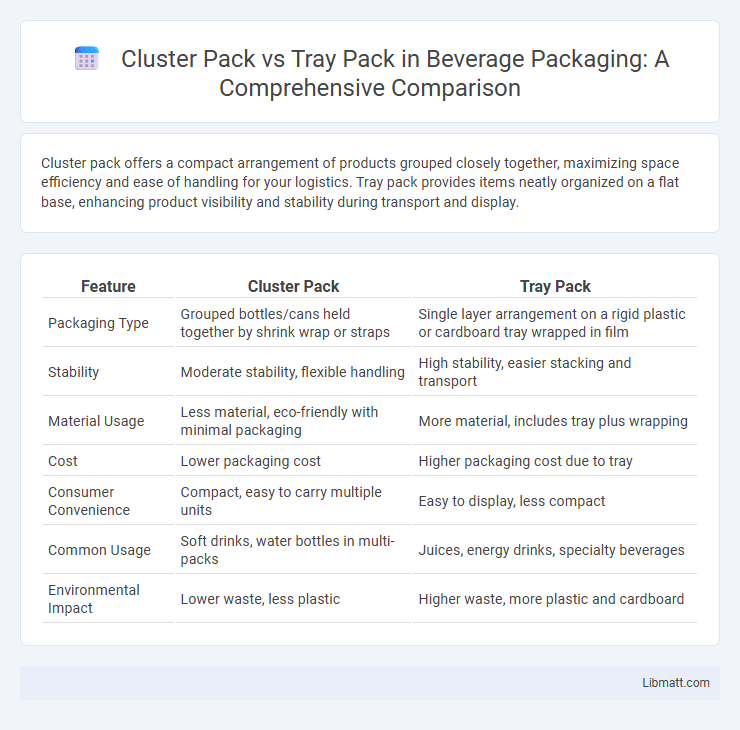Cluster pack offers a compact arrangement of products grouped closely together, maximizing space efficiency and ease of handling for your logistics. Tray pack provides items neatly organized on a flat base, enhancing product visibility and stability during transport and display.
Table of Comparison
| Feature | Cluster Pack | Tray Pack |
|---|---|---|
| Packaging Type | Grouped bottles/cans held together by shrink wrap or straps | Single layer arrangement on a rigid plastic or cardboard tray wrapped in film |
| Stability | Moderate stability, flexible handling | High stability, easier stacking and transport |
| Material Usage | Less material, eco-friendly with minimal packaging | More material, includes tray plus wrapping |
| Cost | Lower packaging cost | Higher packaging cost due to tray |
| Consumer Convenience | Compact, easy to carry multiple units | Easy to display, less compact |
| Common Usage | Soft drinks, water bottles in multi-packs | Juices, energy drinks, specialty beverages |
| Environmental Impact | Lower waste, less plastic | Higher waste, more plastic and cardboard |
Introduction to Cluster Pack and Tray Pack
Cluster Pack and Tray Pack are two common packaging methods used in various industries for organizing and transporting products efficiently. Cluster Pack involves grouping multiple products closely together, often wrapped or banded to form a single compact unit, enhancing space utilization and protection during shipping. Tray Pack places items on a flat tray, typically with compartments or separators, allowing for easier access and visibility while maintaining product stability and reducing damage risks.
Definition of Cluster Pack
Cluster pack refers to a packaging method where multiple individual items, such as fruits or small consumer goods, are grouped closely together and secured with shrink wrap or plastic film to form a single unit. This method enhances product visibility, reduces packaging waste, and facilitates easier handling during transportation and retail display. Cluster packs improve shelf appeal and can optimize your supply chain efficiency by consolidating multiple units into one cohesive package.
Definition of Tray Pack
A tray pack is a packaging method where individual items, such as fruits or vegetables, are arranged in a single layer on a flat tray and covered with clear film or plastic wrap to protect the produce while allowing visibility. This method enhances product presentation, reduces bruising during transport, and simplifies handling in retail environments. In comparison, a cluster pack groups multiple items together without individual spacing, often enclosed in netting or a bag, prioritizing volume over presentation.
Key Differences Between Cluster Pack and Tray Pack
Cluster pack features a group of fruits or vegetables held together by stems or nets, offering easier handling and reduced damage during transport, while tray pack involves arranging individual items neatly in trays, providing better visibility and protection for each piece. Cluster pack typically results in less packaging waste and is suitable for bulk purchases, whereas tray pack is preferred for retail settings where presentation and product separation are crucial. Your choice between cluster pack and tray pack depends on factors like product type, marketing strategy, and shipment requirements.
Pros and Cons of Cluster Pack
Cluster pack offers better protection for delicate products by grouping items closely together, reducing movement and damage during transit. However, cluster packs tend to use more material, leading to higher packaging costs and increased environmental impact. Compared to tray packs, they may limit visibility and accessibility, making them less ideal for retail display purposes.
Pros and Cons of Tray Pack
Tray packs offer easier handling and improved ventilation for products like seedlings or baked goods, reducing damage and promoting freshness. However, they can consume more storage space and may lack the compactness of cluster packs, which better optimize volume for transport. Your choice depends on prioritizing convenience and airflow over space efficiency and packing density.
Packaging Applications: Cluster Pack vs Tray Pack
Cluster pack packaging is ideal for small, closely grouped products like fruits or cosmetics, offering enhanced protection and easy handling for your retail display. Tray pack excels in organizing larger items or bulk quantities, providing stability and efficient stacking for transport and storage. Selecting between cluster pack and tray pack depends on your product size, protection needs, and display preferences.
Cost Comparison: Cluster Pack vs Tray Pack
Cluster packs generally offer a lower cost per unit due to their compact design and efficient use of packaging materials, reducing overall transportation and storage expenses. Tray packs incur higher costs because they require more rigid materials and additional protective layers, leading to increased packaging and handling expenses. Businesses aiming to minimize budget without compromising product integrity often prefer cluster packs for their cost-effective advantages.
Sustainability and Environmental Impact
Cluster packing reduces plastic waste by grouping multiple units into a single biodegradable or recyclable band, minimizing the overall packaging material compared to tray packing. Tray packs often involve bulky plastic trays and shrink-wrap, leading to higher resource consumption and increased landfill contributions. Your choice of cluster packs supports eco-friendly practices by promoting lower carbon footprints and easier recycling processes.
Choosing the Right Packaging Solution
Selecting between cluster pack and tray pack depends on your product type, volume, and presentation goals. Cluster packs bundle multiple items using shrink wrap or netting, ideal for easy handling and promotional sales, while tray packs offer a sturdy base with a clear film cover, enhancing visibility and protection. Understanding your product's shelf life, display needs, and consumer convenience helps determine the best packaging solution for your brand.
Cluster pack vs tray pack Infographic

 libmatt.com
libmatt.com